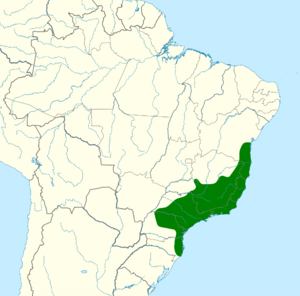Crescent-chested puffbird facts for kids
Quick facts for kids Crescent-chested puffbird |
|
|---|---|
 |
|
| Conservation status | |
| Scientific classification | |
| Genus: |
Malacoptila
|
| Species: |
striata
|
 |
|
| Synonyms | |
|
Malacoptila torquata |
|
The crescent-chested puffbird (scientific name: Malacoptila striata) is a cool bird found only in Brazil. It belongs to a bird family called Bucconidae, which includes puffbirds, nunlets, and nunbirds. These birds are known for their puffy feathers and often sit still for a long time, waiting for insects.
Contents
Understanding the Crescent-chested Puffbird
What's in a Name?
For a while, this bird had a different scientific name, Malacoptila torquata. But since the middle of the 1900s, it has been known by its current name, Malacoptila striata. Scientists use a special naming system called Binomial nomenclature to give each living thing a unique two-part name.
Different Types of Puffbirds
Most bird experts, like the International Ornithological Committee (IOC), think there are two main types, or subspecies, of the crescent-chested puffbird. These are called M. s. striata and M. s. minor. However, another group, BirdLife International, believes these two types are actually separate species. They call them the greater and lesser crescent-chested puffbirds.
What Does the Crescent-chested Puffbird Look Like?
This puffbird is about 17.5 to 20 cm (6.9 to 7.9 in) long. That's about the length of a regular pencil! The M. s. striata type weighs around 40 to 47 g (1.4 to 1.7 oz), which is like a few pieces of candy. The M. s. minor type is a bit smaller.
Feather Colors and Markings
The M. s. striata has a blackish head and back with light brown streaks. Its face has a reddish-brown area around its beak and a light-colored "moustache" stripe. Its wings are brown with light brown spots, and its tail is plain dark brown.
A cool feature is the white crescent shape on its upper chest, with a black band right below it. Its lower chest is reddish-brown, and the middle of its belly is whitish. The sides of its chest and belly are dull brown with wavy, light brown patterns. The M. s. minor type has a brighter chest band and its belly is whiter, without the wavy patterns.
Where Do Crescent-chested Puffbirds Live?
The M. s. striata subspecies lives in southeastern Brazil. You can find it from the states of Bahia and Minas Gerais all the way south to Paraná and Santa Catarina.
The M. s. minor subspecies lives in a smaller, separate area in the states of Maranhão and Piauí in Brazil's Northeast Region.
Their Favorite Places to Be
These puffbirds like to live in different kinds of open areas. They often hang out at the edges of humid lowland forests or in forests that have been logged. They also like secondary forests, which are forests that have grown back after being cut down. You might spot them along roads or at the edges of clearings. They usually avoid the deep parts of the forest. They can live anywhere from sea level up to 2,100 m (6,900 ft) high in the mountains.
How Do Crescent-chested Puffbirds Behave?
What Do They Eat?
Crescent-chested puffbirds usually hunt for food alone. However, some people have seen them following swarms of army ants, just like other birds do. While we don't know all the details of their diet, scientists believe they mostly eat small creatures without backbones, like insects.
How Do They Raise Their Young?
The M. s. striata subspecies breeds from October to December or January. We know of two nests that were found in burrows dug into earthen banks. However, there's still a lot to learn about their breeding habits, what their nests look like, and their eggs.
What Do They Sound Like?
The song of the crescent-chested puffbird is a high-pitched whistle with more than 10 notes. It sounds a bit like a small Tyrant flycatcher, making sounds like bieh, bieh, bieh…. When they sense danger, their alarm call is a high, thin sound that goes down in pitch, like seeee....
What is Their Conservation Status?
The IUCN (International Union for Conservation of Nature) is an organization that checks on how many animals are left in the wild. They follow the idea that the two types of crescent-chested puffbirds are separate species.
The "greater" puffbird (M. s. striata) is listed as being of Least Concern. This means there are still many of them, over 72,000 adult birds. However, their numbers are slowly going down.
The "lesser" puffbird (M. s. minor) is listed as Endangered. This is because the forests where it lives are being cut down more and more. We don't know exactly how many of these birds are left, but their population is also believed to be decreasing.


